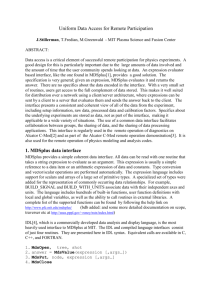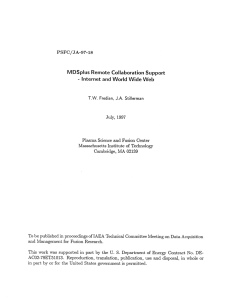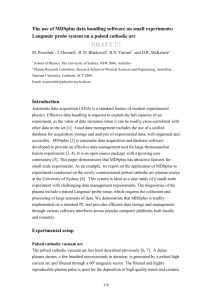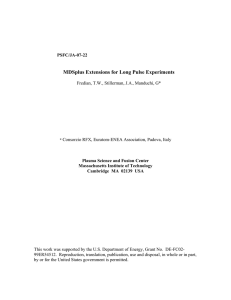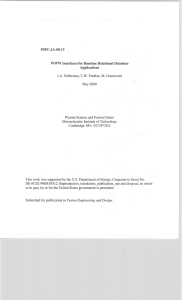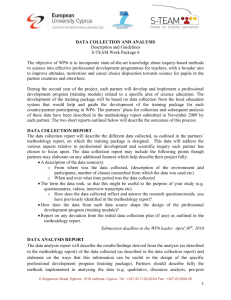Document 10916301
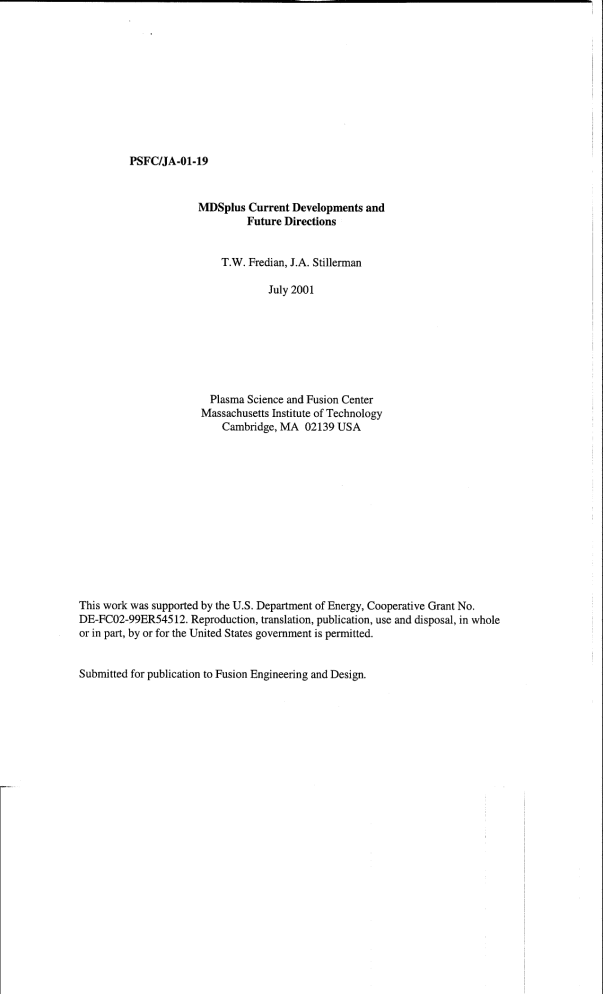
MDSplus
Current Developments and
Future Directions
Thomas W. Fredian and Joshua A.
Stillerman
MDSplus is a data handling software system used widely in the fusion research community. It provides tools for acquiring, storing and analyzing data from fusion experiments, simulations, and analysis codes.
The system also provides a networking system that enables users to access data remotely from any computer on the Internet. The software is now available for most computing platforms. MDSplus is an open source package and as the user community grows, many tools and programs based on MDSplus are being developed at numerous fusion research sites. MDSplus is easily taught to access other data stores and is being used to provide a network gateway to fusion data stored in non-MDSplus formats. Many large physics codes are being fitted to use MDSplus as the primary means of data input and output, removing the necessity to build different versions of the code to access different data formats.
This paper will describe where and how the software is currently being used, identify recent developments and enhancements to the system and present some of the planned improvements to the software.
Background
MDSplus was developed as the result of collaboration between C-Mod at MIT, RFX in
Padova, Italy and ZTH in Los Alamos over the time period of 1987-1991
1
. The system was designed and implemented to operate on the OpenVMS operating system with data acquisition requirements of the order of 10-15 megabytes per machine cycle. Key elements of the design included a hierarchical data storage, a built-in expression evaluator for doing trivial conversions such as digitizer counts to volts , the ability to store many different types and shapes of data in a single data store and extensibility enabling sites to add customization such as support for new data acquisition hardware without the need to recompile or relink the MDSplus system software.
MDSplus was first used on the C-Mod and RFX experiments in 1991-1992 and shortly after adopted by the TCV experiment in Lausanne. The system worked well on these experiments and improvements in networking and computer speeds have enabled the systems to grow to handle the current data acquisition loads now exceeding a few hundred megabytes per shot.
As more and more diagnostics were added to the experiments and users began writing analysis programs which would read data from the MDSplus storage and write results back into the same area it became clear that the hierarchical tree structure of
MDSplus data stores could prove to be very valuable.
Users could readily find the data they were interested in and they could even build analysis programs and visualization tools that were driven by the tree structure. An example of this is the
‘MDSplus’ification of the TRANSP code
2
. TRANSP is a large analysis code written and supported at
PPPL. The code was adapted at MIT to get input data from MDSplus trees and to write the results back into
MDSplus. IDL applications were written to help the user do the appropriate massaging of input data, run the TRANSP code and visualize the output of the code. These applications used the hierarchical structure of the tree to determine the list of inputs and outputs and the types of operations that were applicable to this data. When new inputs or outputs were added to the code, only the tree structure needed to be modified. The applications using this data generally required no modification.
Not long after these experiments started operating, scientists began collaborating from remote locations.
These scientists could connect via the Internet to local computers at the experiment and access the data, but they usually had computing resources at their remote sites that could be used for analyzing the data. More often than not these remote computers were not OpenVMS systems so merely copying the binary data files would not provide a solution. In
1994, MDSplus was enhanced to provide a client/server data connection to remote computers. A very small easily ported client library was created
which could communicate over the Internet to a server process running on the OpenVMS computer that had access to the MDSplus data. This client library was ported to many of the popular varieties of
Unix and to the MS Windows platforms. Now it was possible for applications running on the remote computers running a wide variety of operating systems to access MDSplus data. This remote access capability was demonstrated in a test where the
Alcator C-Mod experiment was controlled and operated from a remote control room located at the
Lawrence Livermore National Laboratory in
California
3
.
The features of MDSplus were becoming attractive to more and more sites but the restriction of using the
OpenVMS operating system was a concern. Both
General Atomics
4
and PPPL
5
agreed to assist in porting the system to the Unix platform. During
1999-2000 the bulk of the MDSplus system was ported to numerous Unix systems and MS Windows.
Since that time MDSplus has been installed at numerous sites on many types of computer platforms
(See Table 1).
Location
1 MIT, Cambridge, MA
2 CNR, Padova, Italy
3 EPFL, Lausanne, Switzerland
4 MIT, Cambridge, MA
5 Taejeon, South Korea
6 General Atomics, San Diego, CA
7 PPPL, Princeton, NJ
8 U of Washington, Seattle, WA
9 U of Washington, Seattle, WA
10 U of Washington, Seattle, WA
11 ANU, Canberra, Australia
12 Frascati,Italy
13 EFDA, UK
14 Tianjin University of China, PRC
15 NIFS, Tajimi, Japan
16 UCSD, San Diego, CA
17 SAIC, San Diego, CA
18 MIT, Cambridge, MA
19 Columbia U, NY, NY
20 Columbia U, NY, NY
21 Kurcatov Institute, Moscow, Russia
22 LANL, Los Alamos, NM
23 LANL, Los Alamos, NM
24 U of Washington, Redmond, WA
25 LBL, Oakland, CA
26 U of Wisconsin, Madison, WI
Recent MDSplus work
Machine/ First CPUS Platforms
Code Used
C-Mod 1991 80+ OVMS,WNT,Linux,Tru64,MAC
RFX 1991 9 OVMS,Tru64,Solaris,Linux,WNT,vxWorks
TCV 1992 16 OVMS,Linux
PTF 1995
HANBIT 1996
3 OVMS
?
OVMS,Solaris
DIII-D 1997 40 Tru64,HPUX,Linux,WNT,IRIX,OVMS,MacOS
NSTX 1997 22 OVMS,Solaris,Tru64,Linux,WNT
ZaP
HIT
TIP
H1
1998
1998
1998
20
"
"
Linux,WNT,OVMS,Tru64
Linux,WNT,OVMS,Tru64
Linux,WNT,OVMS,Tru64
1999 12 OVMS,Tru64,Linux,WNT
FTU
JET
1999 1 Tru64
2000 60+ Linux,Solaris
HT-7U 2000
CHS 2000
1
10
W N T
OVMS,Tru64,WNT
PISCES 2000
NIMROD 2000
LDX 2001
HBT-EP 2001
3
3
3
4
W N T
Linux, SGI Irix, Cray Unicos
OVMS,MAC
OVMS,WNT
CTX
T-10
MTF
2001
2001
2001
FRX-L 2001
TCS 2001
NIMROD 2001
MST 2001
" OVMS,WNT
1 Linux
1 SunOS
" SunOS
7 WNT,MAC,OVMS
1 Cray T3E
2 OVMS
Table 1 – Current MDSplus Installations
MDSplus is used in a variety of ways such as providing a complete data acquisition and analysis various computer platforms, increasing its robustness and enhancing its functionality. system, or providing data handling for analysis results only or providing remote access capabilities to existing data systems.
A core development team continues to enhance the
MDSplus system, expanding its availability on
Installation Enhancements
Over the last year significant work has gone into making MDSplus easier to download and install.
Binary kits for many varieties of Unix exist using the
RPM (Redhat Package Manager) format. A setup procedure is also available for installing MDSplus on
Windows (95/98,NT and 2000). In addition, the build
procedures for compiling and linking MDSplus have been enhanced to make it easier to build the software on a large variety of platforms.
New Installations
There have been many new installation performed over the last year as is shown in Table 1 above. The growing base of MDSplus installations has made it easier for scientists to shared data, analysis programs and visualization tools. We anticipate this growth will continue in the near future.
Java Applications
The MDSplus team in Padova has been developing
Java based applications for viewing and manipulating experimental data. . This includes enhancements to the Jscope and Jtraverser applications as well as new
Java based action dispatcher and action monitor applications.
Large Storage Device Support
The MDSplus file access routines have been enhanced to enable the system manager to modify the algorithm used by MDSplus to locate the files associated with a particular pulse number. In the past the system required the files to be located in one of a specified list of directories. A new mechanism was added such that the system manager could use digits of the pulse number combined with the tree name to specify the directory in which the files are to be found. This is important for both performance and management reasons when sites begin using large
RAID systems, arrays of many magnetic disk drives.
Data acquisition support
Serveral extensions have been added to MDSplus to enable the use of an ever-increasing selection of data acquisition equipment. Labview virtual instruments have been developed to enable users to read and write
MDSplus data using the National Instruments
Labview system. Device support was also added to access VM E shared memory modules to support the
CINOS subsystems developed for the CHS experiment at NIFS. A MS Visual Basic interface to
MDSplus was also developed to enable users to read and write MDSplus data from Visual Basic applications on windows systems.
Support was added to MDSplus to perform data acquisition using compact PCI based transient recorders.
6
These systems are based on PC’s running the Linux operating system. An MDSplus system is run on the PC and can be used as standalone data acquisition system or can be controlled remotely using the MDSplus remote access capabilities.
Support for accessing CAMAC using either the
Jorway 411 SCSI Serial Highway Driver or the
Kinetic Systems 2145 SCSI Serial Highway Driver has been developed for the Linux platform. The software that emulates the original ORNL CAMAC library utilizes the generic SCSI driver available on
Linux. This package is in final testing and will be included in the MDSplus distribution and CVS source code repository in the near future.
Analysis Codes
Many widely used analysis codes are being converted to use MDSplus as the vehicle for data input and output. The codes will then have a standard mechanism for accessing data and can use the built in remote access capability of MDSplus to access data anywhere on the Internet. The user of the code can use familiar data manipulation and visualization tools on both the inputs and outputs of the code. Some of the codes modified include: TRANSP, PEST, GS2,
LIUQE, TORAY, EFIT, NIMROD, ONETWO,
GATO, GKS, CER analysis codes.
Future Enhancements
Globus/Akenti security/authentication
The remote access capability available in MDSplus currently uses a very rudimentary authentication method. As the size of the MDSplus community grows and the use of MDSplus client/server communications expands to provide data access to fusion research data and computing services, it is becoming more important to protect these valuable resources against unauthorized use. Over the next two years we plan to exploit the state-of-the-art, certificate based, authentication, authorization, and encryption technologies provided by the Globus
Security Infrastructure
7
and the Akenti authorization service in the MDSplus client/server communication system.
MDSplus Documentation / FAQ system
While there are numerous documents
8
available describing MDSplus at various MDSplus installation sites, the MDSplus documentation is still quite sparse and unorganized. We plan to reorganize the existing documentation and add an MDSplus FAQ (frequently asked questions) system. A web based FAQ system has been developed at General Atomics in San Diego that uses an MS SQL Server database to organize the information. We hope to use this system to present the MDSplus FAQ information. We also are bringing online a new Linux based server system which will be used to server the MDSplus documentation, cvs repository and binary kit distribution.
Additional data acquisition device support
The SCSI CAMAC Serial Highway support will be ported to other Unix platforms and Windows where generic SCSI drivers are available.
Conclusions
The MDSplus system is now widely used throughout the worldwide fusion research community. It provides a uniform remote data access capability to experimental and analysis data. It is expected that the number of users of this software will continue to grow. MDSplus development is no longer limited to the original authors and numerous sites are developing MDSplus based tools that should prove useful to the entire fusion sciences community.
The remote access capabilities of MDSplus make it easy to share the valuable fusion research resources, namely data and computing facilities. A major task ahead of us is to ensure that these resources are protected from unauthorized access. We hope to solve this problem using modern certificate based encryption and authentication methods in the near future.
MDSplus is quite flexible and powerful and can support a wide variety of data handling needs.
Unfortunately the knowledge required for tapping many of its capabilities is distributed quite inefficiently, either by word of mouth or email exchanges. With the help of the MDSplus community we hope to begin to build a much more extensive online MDSplus documentation set which can guide a user from the early stages of MDSplus use through the use of some of the systems more advanced functionality.
1
Stillerman,J.A., Fredian,T.W., Klare,K.A.,
Manduchi,G., MDSplus data acquisition system,
Review of Scientific Instruments Vol 68 No 1
January 1997
2
Jeff Schachter, Local Transport Analysis for the
Alcator C-Mod tokamak , MIT Plasma Science and
Fusion Center PhD Thesis , PSFC/RR-97-12, 1997
3
S.Horne, et. al., Remote Control of Alcator C -Mod from LLNL, Fusion Technology, 32, (1997), 152.
4
http://fusion.gat.com/comp/analysis/mdsplus/
5
http://nstx.pppl.gov/nstx/Software/
6
Stillerman,J.A., Fredian,T.W., Compact PFC based
Data Acquisition with MDSplus, these procedings
7
I.Foster and C.Kesselman, Globus: A Toolkit-Based
Grid Architecture in The Grid: Blueprint for a New
Computing Infrastructure, 1999, Morgan Kaufmann,
259-278.
8
http://www.mdsplus.org/
